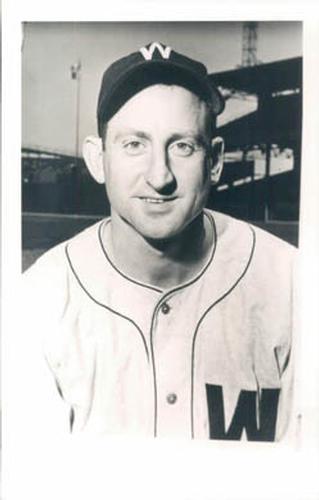September 28, 1949: Washington’s Ray Scarborough stops Red Sox, ties up AL pennant race
 On the morning of Wednesday, September 28, 1949, the Boston Red Sox retained a one-game lead over the New York Yankees in the American League pennant race. That evening Boston faced the second of three games at Washington’s Griffith Stadium against the Nationals before departing for New York to finish the season.
On the morning of Wednesday, September 28, 1949, the Boston Red Sox retained a one-game lead over the New York Yankees in the American League pennant race. That evening Boston faced the second of three games at Washington’s Griffith Stadium against the Nationals before departing for New York to finish the season.
Exactly a year before, the Red Sox had been in a nearly identical situation, playing the Nationals while the pennant race promised to go down to the last weekend against the Yankees. Then they had suffered a loss to Ray Scarborough, the Nationals’ ace.1 They went on to finish in a regular-season tie with the Cleveland Indians for first place, then lost the pennant to Cleveland in the tiebreaker game.
Scarborough, a 32-year-old right-hander, had been the second-best pitcher in the AL in 1948 by pitching WAR but struggled in 1949.2 His ERA climbed by two runs to 4.77 and he walked more batters than he struck out (88-74). Three previous starts against the Red Sox echoed this decline: After tossing a complete-game victory in May, Scarborough had been tagged for 11 runs in their next two confrontations. However, he had turned his season around in September, winning two of three decisions and lowering his ERA below 5.00 for the first time since April. He also carried a reputation for beating the best teams in the league, even provoking the Red Sox to offer “fabulous cash sums for him, plus a passel of players” at some undisclosed point.3
The Red Sox were hot themselves. Below .500 as late as July 4, they had overtaken the Yankees by winning more than three-quarters of their games since the start of August. On the mound they started the youngest pitcher in the AL, 20-year-old southpaw Chuck Stobbs. A former bonus baby,4 Stobbs entered the rotation after the All-Star break and responded with eight victories against three defeats. This included all five of his starts in August, one of which came against Scarborough. Nonetheless, manager Joe McCarthy chose to rely as much as possible on the team’s two aces, Mel Parnell and Ellis Kinder, in September, reducing Stobbs’ share to one relief appearance after September 11.
After a rain delay of nearly an hour, the September 28 contest opened.5 Boston’s offense sputtered from the start. Dom DiMaggio and Ted Williams, who had reached base in 84 consecutive contests, both struck out, sandwiching a Johnny Pesky fly to center. Williams had struck out only 47 times in 714 plate appearances entering the day’s action.
Stobbs also proved shaky, allowing singles to Eddie Yost and former Red Sox outfielder Sam Mele to start the bottom of the first. He worked around this unpromising opening by turning the back-to-back comebackers into force outs before Eddie Robinson grounded out to second.
After Scarborough punched out another pair in the top of the second, Stobbs retired Washington’s batsmen in order. He then singled in the third inning for Boston’s first hit of the game, but DiMaggio’s wobbler to short forced him at second and ended the inning.
After two more shutdown innings from each starter, Stobbs returned to the batter’s box with one out in the sixth, the game remaining scoreless. As he did in his first at-bat, he aided his own cause with a bloop double to left. This time, DiMaggio singled to drive Stobbs home with the game’s first run. Before the Red Sox could sustain an offensive action, potentially potent with Williams now on deck, Pesky grounded into a double play.
Perhaps this would have made no difference, for after another quiet inning from Washington’s bats, Williams struck out for the second time to open the seventh. This would prove to be his final whiff of the season, yet also his first multi-strikeout game in nearly three months (since July 1 in Philadelphia). Otherwise, the frames continued to pass with little distinction, occasional threats being smothered by double plays.
In the bottom of the ninth, the Red Sox needed three outs to secure a 1-0 victory, and all but ensure at least a tie for the AL pennant. Stobbs, perhaps tired from his extensive effort after weeks of disuse, gave up a single to short left field by Roberto Ortiz. Washington manager Joe Kuhel seized this opportunity, substituting Gil Coan to run for Ortiz and having pinch-hitter Bud Stewart sacrifice to move the tying run into scoring position.
Eddie Robinson then placed enough bat on an outside curveball to ground the ball past Stobbs and nearly into center; second baseman Bobby Doerr’s energetic play prevented Coan from scoring and tying the game. But Al Kozar notched the third single of the inning, driving the ball between third and short to score Coan and place Robinson as the winning run at second.
Joe McCarthy brought in righty Ellis Kinder to extinguish the Nationals’ attack, but Kinder allowed another single on his first pitch to Sam Dente, loading the bases. Kuhel now made his third substitution of the frame, having left-handed-batting Buddy Lewis pinch-hit for the right-handed Al Evans. McCarthy responded by removing Kinder in favor of southpaw ace Mel Parnell.
At this point, a light rain began to fall, a vestige of the more vigorous downpour that caused the delay earlier. Lewis fouled off Parnell’s first offering, then let a ball pass. As Parnell began his windup, Lewis received the squeeze sign. Unfortunately for the Nationals, Red Sox catcher Birdie Tebbetts noticed Eddie Robinson starting prematurely for home and quickly sprang up for a pitchout. Tebbetts’s tag on Robinson turned the situation from the bases being loaded with one out to two on, two out. The Red Sox no longer needed to attempt to induce a double play, improving their tactical flexibility as well as their chances of prolonging the contest into extra frames.6
With the count now 1-and-2, Parnell threw a waste pitch, a curve low and outside, to try to nab Lewis swinging. He did too well, as the ball curved so deeply and widely that it bounced in the dirt and then by Tebbetts. As it rolled toward the grandstand, Kozar raced home and scored the winning run without a play at the plate.
The Nationals had scored two runs in the bottom of the ninth despite no extra-base hits and Robinson caught stealing at home. The best hit ball of the inning was Dente’s single to right, as both Ortiz and Robinson were described as only getting the end of the bat on the ball and Kozar’s single merely found a hole.7 On the other hand, Scarborough pitched better than Stobbs, allowing only four hits while striking out seven, including Williams twice. Boston’s starter ended the day with seven hits allowed in addition to two walks issued, against one strikeout.
In the clubhouse, Dente exulted in getting the decisive hit. “I have a letter here in my locker from a fan. He accuses me and the other fellows on the club of laying down against the Red Sox this year. I hope that game satisfies him.” Dente also received plaudits from his coaches and teammates for his fine fielding. He had handled 13 chances cleanly and initiated double plays twice.8
That rain returned in the night, delaying what was supposed to be the next day’s contest by an afternoon. The Red Sox won the makeup contest, 11-9, while the Yankees lost to the Athletics, placing the Red Sox ahead by a game with two to play. However, Boston failed to win either contest in New York, as the Yankees won the pennant and then defeated the Brooklyn Dodgers in the World Series. The Yankees then proceeded to win another four consecutive World Series while the Red Sox slowly faded from contention throughout the early 1950s.
Stobbs had a successful major-league career as a swingman and innings-eater, pitching two more seasons in Boston before a season with the Chicago White Sox. He spent the bulk of his career with Washington, pitching for them (except for a brief tenure as a Cardinal) until they moved to Minnesota and became the Twins, playing his last season in 1961. Stobbs is perhaps best remembered as the unfortunate pitcher who delivered Mickey Mantle’s legendary 565-foot home run.9
As for Scarborough, his penchant for winning big games and giving Ted Williams fits led to his acquisition by the Red Sox in December 1950. But what magic he once conjured had dissipated, as Scarborough saw his ERA increase again, this time to 5.09, though strong offensive support ensured a winning record of 12-9. Further decline in 1952 found him sold to the Yankees down the stretch, for whom he provided a 2.91 ERA. Serving in Casey Stengel’s bullpen for most of 1953 to moderate success, Scarborough was released in August and finished his major-league career with the Detroit Tigers that September.10
Acknowledgments
This article was fact-checked by Laura Peebles and copy-edited by Len Levin.
Photo credit: Ray Scarborough, Trading Card Database.
Sources
In addition to the Sources cited in the Notes, the author consulted Baseball-Reference.com and Retrosheet.org for material including the box scores.
https://www.baseball-reference.com/boxes/WS1/WS1194909280.shtml
https://www.retrosheet.org/boxesetc/1949/B09280WS11949.htm
Notes
1 David Halberstam, Summer of ’49 (New York: William Morrow and Company, Inc. 1989), 231; Shirley Povich, “Hats Off …! Ray Scarborough,” The Sporting News, October 5, 1949: 25.
2 Scarborough’s 5.2 WAR, as determined by Baseball-Reference, was second to Detroit Tigers left-hander Hal Newhouser (6.2).
3 Shirley Povich, “Scarborough Lone Rose on Senators’ Hill,” The Sporting News, September 28, 1949: 8.
4 Halberstam, 31; Bill Nowlin, “Chuck Stobbs,” SABR BioProject, accessed May 13, 2025. https://sabr.org/bioproj/person/chuck-stobbs/.
5 Hy Hurwitz, “Parnell’s Wild Pitch in Ninth Costs Game,” Boston Globe, September 29, 1949: 1.
6 Hurwitz.
7 Hurwitz.
8 Burton Hawkins, “Dente’s Great Game at Short Puts Crusher on Critical Fan,” Washington Evening Star, September 29, 1949: 3.
9 Nowlin, “Chuck Stobbs”; Jane Leavy, “Lives to Remember: Chuck Stobbs, 1929-2008,” accessed June 3, 2025. https://janeleavy.com/essay/chuck-stobbs-2/.
10 Bill Nowlin, “Ray Scarborough,” SABR BioProject, accessed May 13, 2025. https://sabr.org/bioproj/person/ray-scarborough/.
Additional Stats
Washington Nationals 2
Boston Red Sox 1
Griffith Stadium
Washington, DC
Box Score + PBP:
Corrections? Additions?
If you can help us improve this game story, contact us.


